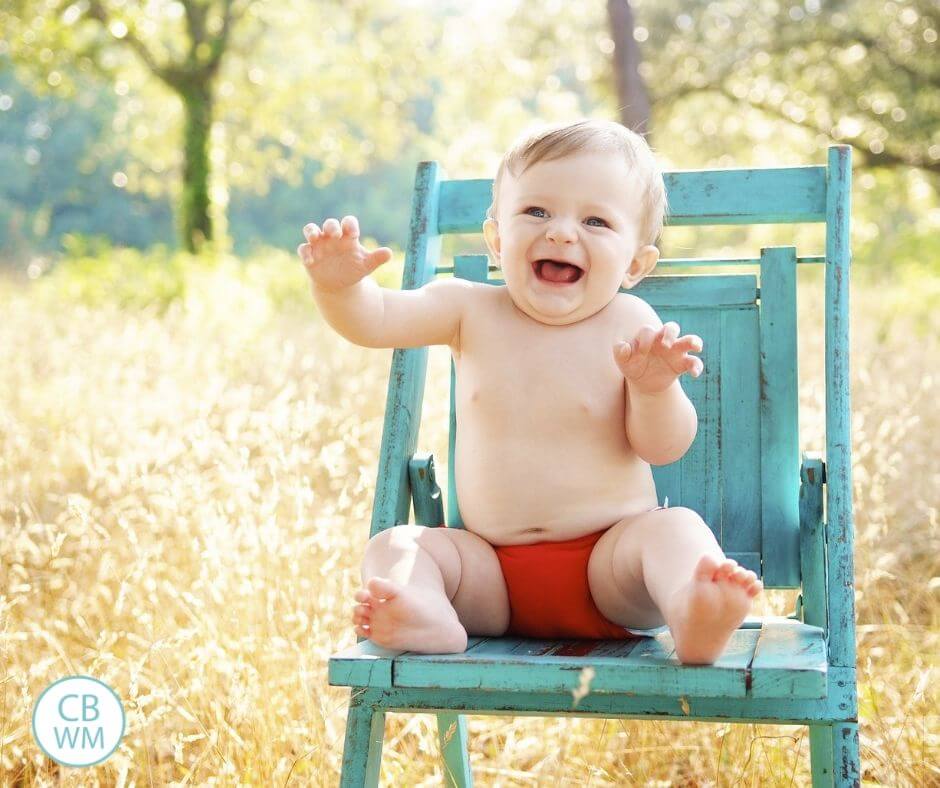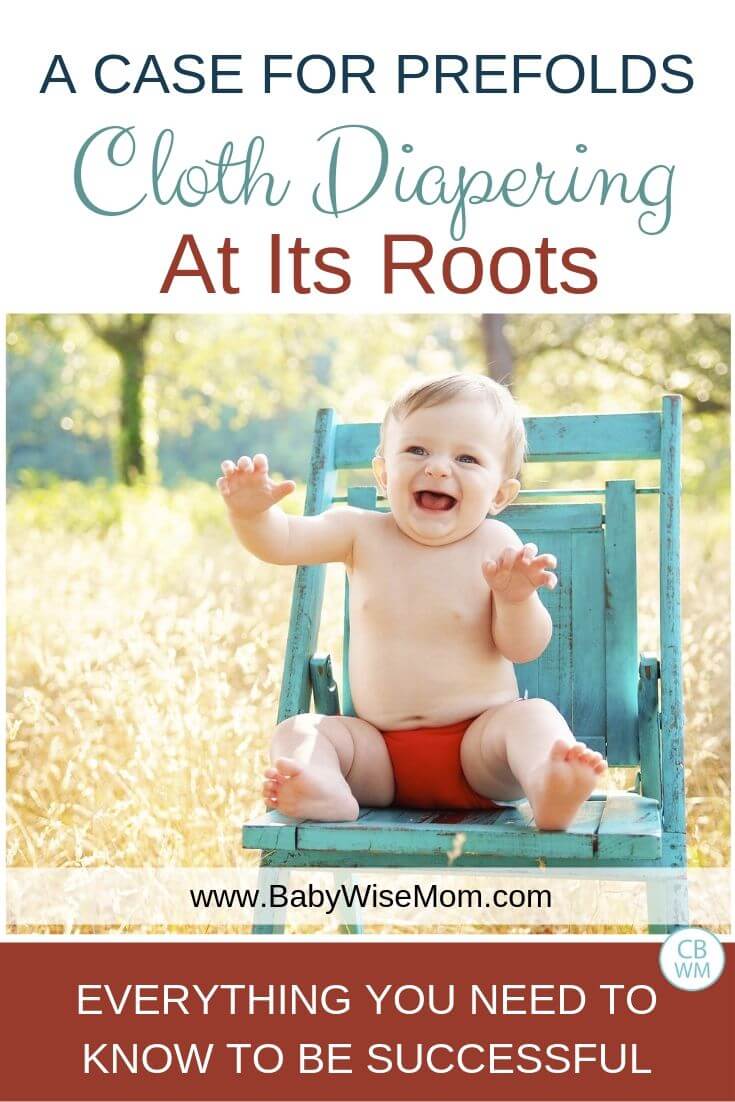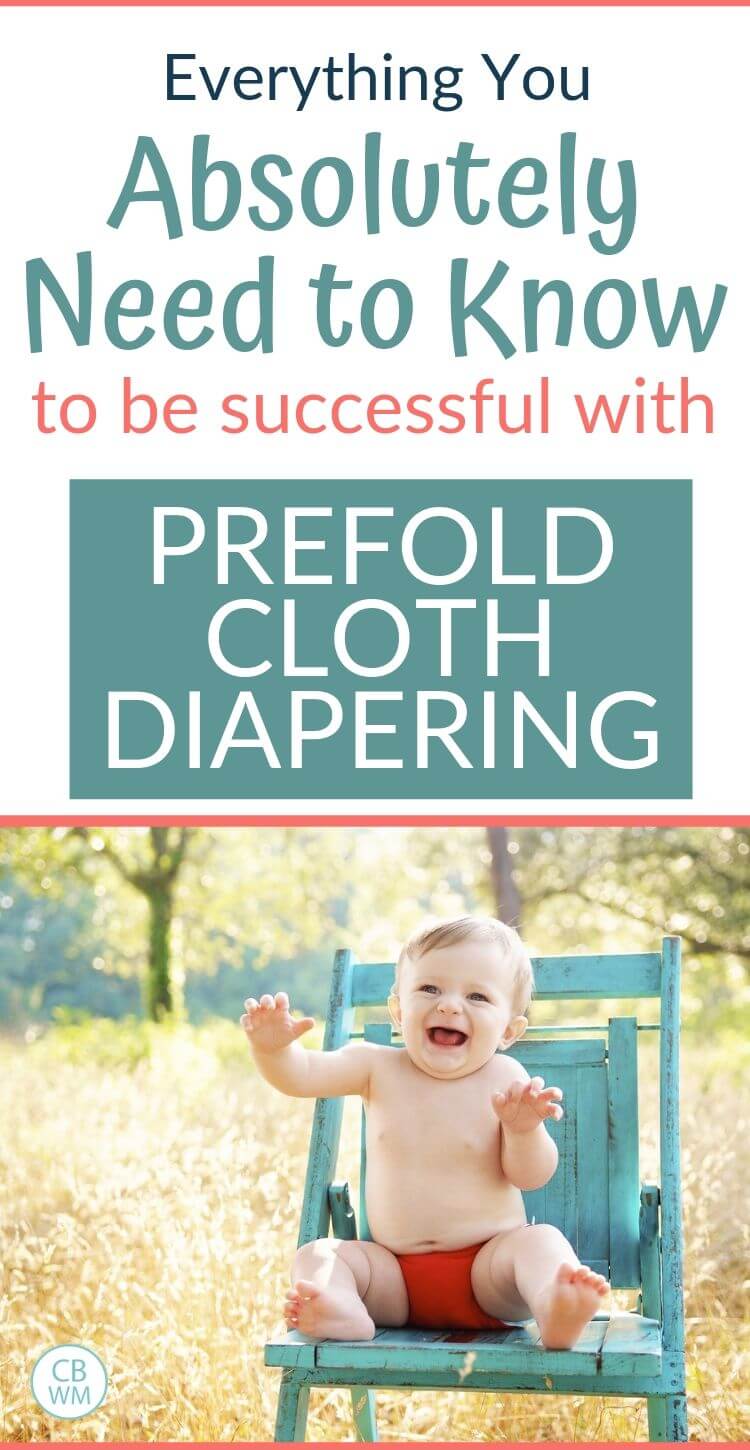Everything you need to know about cloth diaper prefolds. Know the benefits, how many to get for your baby, and what the best prefolds are for baby.

by Autumn Battaglia
Until I found myself kneeling on the laundry room floor, trying to get the stink out of some bamboo-charcoal cloth diapers that were also leaking up the front with every nap, I thought I had the whole cloth diaper system figured out. I had researched brands, considered the cost, adjusted laundry detergents multiple times, looked into the specific water composition in our region, prepped the diapers as instructed, and hang-dried the inserts all over our home for what was often days on end. But the inserts still smelled like sewage and I knew something had to change.
I was a first-time mom with my first little boy. Thanks to Babywise sleep principles, he was sleeping twelve hours through the night and napping like a champion. Then… the leaks started happening. It was a minor inconvenience at first- one that most people assume just comes with the territory of babies. But when the fancy-schmancy cloth diapers that I had spent SO LONG picking out and researching to include on my carefully curated baby registry started causing my dream-sleeper to wake early from naps, I was certain this was not the way we could continue on. I contacted the company for suggestions and reached out to other cloth-diapering moms. Turns out that belly-sleeping boys tend to be very heavy front-wetters. I won’t go into the specifics of why these diapers leaked, as there were a variety of factors, but it was clear they were not going to work for us.
Luckily for me, Amazon was wonderful and was willing to give us a full refund for the diapers, even though they were outside of the return window. I still sometimes think of the poor person who was on the receiving end of that box of stinky, used cloth diapers that they insisted we ship back.
It was back to the drawing board for cloth diaper shopping and this time I wised up and started with a friend who I knew had successfully cloth-diapered a few babies of her own. She introduced me to the idea of prefolds and promised they would solve all of my problems. Until she told me how she used them on her babies, I had only ever seen them used as burp cloths by modern-day moms. When I talked to my own mom about it, she reminded me that I was actually a prefold-and-pin baby myself in the 1980s. So, as is often wise in many areas of life, I decided to go back to the basics. Prefolds.
If you’re anything like me, you want the cost-saving benefits of cloth diapers, but also something that’s easy to use, easy to wash, and will hold up through multiple children. That is exactly what prefolds are and I’m going to walk you through the why and how of prefolds.
Post Contents
Why prefolds?
- Simple and affordable. Prefolds are the simplest of ideas; one large piece of fabric (called a ‘flat’), folded repeatedly to form a multi-layered pee-sponge to wrap around your baby. Not only are they simple, but they are extremely cost-effective. If you search just about any cloth diaper site, you will see prefolds praised to be the most budget-friendly cloth diapers, which I have found to be true. I was able to return just one dozen of my pocket diapers to buy four dozen prefolds and covers with money left over. More on the cost later.
- Customizable. By far my favorite part of using prefolds is that they are SO customizable to your needs. For us, we needed something that could be heavily padded in front and the “newspaper fold” fit the bill. With girls, you’ll want something with more centered absorbency; “bikini twist”. Newborns have very watery stools, so you’ll want something that keeps it from running over the edges; “jelly roll fold”. Prefolds do ALL THESE THINGS just depending on how you fold or roll them.
- No-fuss care. Prefolds are extremely easy to care for. I’ll go into the care part later, but believe me when I say that this was a huge seller for me. I had no idea how to care for bamboo-charcoal diapers despite my research and best efforts, but cotton, I can manage!

How do I buy prefolds?
Prefolds come in a rectangular shape that’s composed of three panels, the middle being the thickest. You will often see the absorbency or layering of prefolds written out as 4x8x4. That means there are 4 layers of absorbency on the outer two panels and 8 layers of absorbency in the middle. You can get prefolds in a variety of thicknesses, but I personally recommend the 4x8x4.
Prefolds come in a variety of materials, as well. Most are bleached or unbleached cotton, but some are bamboo-organic cotton blends. We have purchased both bleached and unbleached cotton, just dependent on pricing and sales at the time. The main difference: bleached come already bleached and washed and just require one wash cycle before they’re ready to use. Unbleached usually require a good 4-5 washes before the natural oils are washed off and they’re at their maximum absorbency. For this reason, unbleached are usually cheaper.
There are many sizes of prefolds available, from preemie to toddler. In my experience with my very average-sized boys, we have some infant size, some premium size, and some toddler size. In highsight, I would not buy the infant size again because they’re really in them for such a short period of time. However, when my second was born, my first was still in the premium size and I didn’t have enough for both of them, so I went ahead and ordered the smaller size. If you are thinking you may have children fairly close in age (two years or smaller age gap), having the infant size is nice. Your other option is to bump the older child up to the toddler size and put the baby in the premiums. All this to say, you can probably get away with just the premium and the toddler. Yes, your newborn will look goofy with a huge puffy bottom, but it’s cute.
Now, there are a few other pieces you need to get to make your prefold cloth-diapering system complete. You need diaper covers and something to hold the diaper together. To hold the prefold closed, I love Snappis. You can buy them tons of places online and in stores and they’re cheap. They’re extremely durable (I’ve actually used the same one all day, every day for three years and it’s still holding up!) and simple to use. You hook the little teeth on one side of the diaper, stretch across to the other side and hook the teeth in that side, and then pull down and hook the teeth below. Side note: I’ve never once injured my children using a Snappi despite wiggly, rolling, and tantrum-inducing diaper changes, in case you were concerned about that. There are other closure options, but we love Snappis.
Now onto the covers. Prefolds, being made of cotton are obviously not waterproof, so you need a cover that is. The same friend who recommended prefolds to me also told me about Flip One-Size Reusable covers and I’ve never tried, nor needed to try anything else. They’re simple (do you see a pattern to my choices? I’m all about simplicity). They’re made of 100% laminated polyester and NOTHING gets through these bad boys. They’re one-size and adjustable with multiple sets and options for how to use the snap closures. So you only need to buy them once! Ours have held up from newborn through potty-training with no issues. Once my oldest was potty-trained, I did throw his covers out because they were pretty worn and the elastic was starting to get over-stretched on some of them. But I know some people will just replace the elastic. I’m not that crafty and at the low price point they are, I have no issue throwing them out. They do come in ALL kinds of cute patterns, but I’ve stuck to the basic colors because they’re usually the cheapest.
What I love best about Flip covers is the reusable part. Since there’s no fabric inside, just the laminate, they can be used until either they stink or get soiled. I’ve found that if we have a series of really wet diapers, sometimes they need to be changed daily. If poop leaks out of the prefold, the cover catches it, and I then wash both the prefold AND cover. But there have been times that I’ve used the same cover for almost a week. Which means that you don’t need very many of them! I have five for each child and that is more than enough, in my experience. I’ve had a handful of times that we’ve had a lot of runny-poopy diapers due to illness and all my covers have been dirty, but very few times ever. Usually I have at least three or four clean ones laying around.
Convinced? Here’s how to buy.
I’ve purchased all of our prefolds and Snappis on https://clothdiaper.com/ which sells OsoCozy brand prefolds. There are other brands, but we use OsoCozy and they’re fantastic. The website has super deals, free shipping over $49 in the U.S., and even offers bundles. I’ve not found consistently cheaper prices anywhere if you’re looking to buy new. AND they often have huge discounts on “Seconds” which means they’re just factory imperfect. They might have some wrinkles, loose threads, a small stain, etc. Nothing that will affect their usability. I’ve purchased “Seconds” before and cannot even tell what’s “wrong” with them. I highly recommend this option to really save some money! I’ve purchased most of our Flip covers on ebay.com because I’ve been able to find really good deals on them new. However, many stores, including Target, carry them. I’ve also found many people selling them new or like-new on Facebook Marketplace. The same is true for the Snappis and prefolds themselves. There’s always someone out there who has some to unload.
So here’s EXACTLY what I would buy if I had to do it all again:
-24 OsoCozy PREMIUM 4x8x4 Unbleached Prefolds (Factory Seconds)= $45.98
-24 OsoCozy TODDLER 4x8x4 Better Fit Unbleached Prefolds (Factory Seconds) = $43.98
– 3-Pack Snappis = $9.99
– 5 Flip One-Size Reusable diaper covers = $50
Grand total: $149.95
Wow, right?! You can cloth diaper for less than $150! Buying the Seconds will help you out a lot, but they’re not always available in the sizes you need, so if you see them available, buy them! The Flip covers can vary a lot in price depending on where you buy, what patterns you buy, etc. but I’ve not had a hard time finding them new for $10 each.
How do I care for all these prefolds I just bought?
Whenever I talk to people about prefolds, I have a hard time truly picking out my favorite part of them, but caring for them is definitely up there. They are SO easy. No fuss. Cotton is an amazingly forgiving textile, so you basically treat your prefolds however you like and they WILL NOT fall apart. In the collective 4.5 years of using and caring for prefolds, I’ve not yet lost one. Not a single one even has so much as a loose hem or string. They are SO durable.
My routine? With poopy diapers, I swish it around in the toilet and give a few flushes while holding a clean corner. Just enough to remove anything really gross. (Side note: not necessary with babies before they’re eating solids because their poop will just disintegrate in the wash, so those first 4-6 months of poop don’t need to be swished/flushed.) You can also buy a diaper sprayer to attach to your toilet, but I have no experience with them. Then, like with just wet diapers, I throw them in a dry diaper pail lined with a normal trash bag, though you can buy reusable ones too. Every 2-3 days, I dump the whole pail into my front-loading washing machine. I have a “Heavy Duty” cycle that I like to use. My old machine did not have this cycle, so I’d usually run a rinse cycle, THEN a normal wash cycle. I use the same laundry detergent I use on the rest of our clothes. My sons have both had mild eczema and this has never been a problem. This is also a HUGE cost-saver with cloth-diapering because many kinds require very specific detergents. My old cloth diapers did and it was expensive. Every few weeks or so, I might splash in a little bleach just to get out some really stinky stains or if I notice the diapers start smelling a bit like ammonia. From what I can tell, this happens with almost all cloth diapers at some point, but with cotton prefolds, you can just bleach it out. To dry, I often line-dry them in my basement in the winter or outside in the summer and just toss them in the dryer for just a short cycle when they’re almost completely dry. This last part just takes a little bit of the crunchiness out of them, so they’re a bit softer. Not necessary, but I do it. You could also just toss them straight from the washer into the dryer.
That’s it! There is no fussiness to cotton prefolds, which I am SO thankful for. At the start of this, I mentioned the stink and the DAYS of line-drying and special detergents I was using with my other cloth diapers, but there’s not of that here. Just simple, basic detergent and wash cycles. There’s no “stuffing” to do like you do with pocket cloth diapers. So. Easy.

The (very few) downsides to prefolds
- Night time absorbency. I know there are all kinds of options available to double-stuff, layer, and pack cloth diapers in a way that makes them usable for nighttime. However, in my two experiences, I have not found a way to make cloth diapers work overnight for me. It’s just too many hours and too much pee. As newborns, prefolds work fine because they’re up to feed during the night and mine would often poop as well, so I changed the diaper a few times each night. When they started sleeping those six or more hour stretches, the prefolds just could not keep up. At that point, we use disposable at night.
- Learning curve/becoming a prefold origami master. Diapering a child can be tough when they learn to roll and flip and tantrum. Now throw in having to do a little bit of folding and Snappi-ing and things can get a little tough. It takes a few days to really get the hang of the dexterity needed, but my husband, who was originally intimidated by the idea, figured it out. The various ways to fold the prefold to serve your needs is, as I said before, one of my favorite things about prefolds, so once you get your system down, it’ll be smooth sailing.
As you can see, the pros outweigh the cons about one million to one. Prefolds may seem just like your grandmother’s idea of cloth-diapering, but with a little patience and determination, I am convinced that anybody CAN manage prefolds and that they are truly the best on the market. There’s a reason they’ve been around longer than any other kind of cloth diaper. Give them a shot. You won’t be disappointed.
